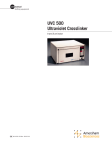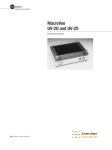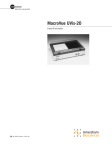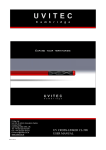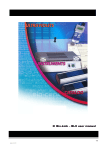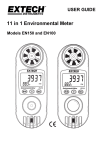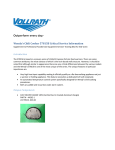Download Hoefer UVC 500 Ultraviolet Crosslinker
Transcript
user manual blotting equipment Hoefer UVC 500 Ultraviolet Crosslinker transilluminator um UVC500-IM/Rev. F0/04-04 Page finder UV Crosslinker function and description . . . . . . . . . . . . . .1 Unpacking . . . . . . . . . . . . . . . . . . . . . . . . . . . . . . . . . . . . . . . . . . .2 Specifications. . . . . . . . . . . . . . . . . . . . . . . . . . . . . . . . . . . . . . . .3 Important safety information . . . . . . . . . . . . . . . . . . . . . . . . . .4 Operating instructions . . . . . . . . . . . . . . . . . . . . . . . . . . . . . . . .5 Energy setting Time setting . . . . . . . . . . . . . . . . . . . . . . . . . . . . . . . . . . . . . . .6 . . . . . . . . . . . . . . . . . . . . . . . . . . . . . . . . . . . . . . . . .8 Care and maintenance ............................. 10 Bibliography . . . . . . . . . . . . . . . . . . . . . . . . . . . . . . . . . . . . . . . 12 Ordering information . . . . . . . . . . . . . . . . . . . . . . . . . . . . . . . 14 • pi UV Crosslinker function and description The Hoefer™ UVC 500 Ultraviolet Crosslinker provides a uniform and intense source of ultraviolet (UV) light for such uses as: • DNA crosslinking • DNA nicking • Rapid restriction site mapping • Testing RecA function • Ultraviolet sterilization • Elimination of PCR contamination The internal photo-feedback system continually measures the energy delivered within the chamber and automatically deactivates the UV light source once the programmed energy level is reached. This system also automatically adjusts to variations in UV intensity that occur as lamps age. Fig 1. Crosslinker front view. Pull the door open along this handle View window LED display Keypad Power switch • p1 Unpacking Unwrap all packages carefully and compare contents with the packing list, making sure all items arrived. If any part is missing, contact your local sales office. Inspect all components for damage that may have occurred while the unit was in transit. If any part appears damaged, contact the carrier immediately. Be sure to keep all packing material for damage claims or to use should it become necessary to return the unit. • p2 Specifications Ultraviolet wavelength and sources • 254 nm (shortwave) • Five 8-W 254 nm UV dual bi-pin discharge type tubes Features • Microprocessor controlled UV sensor feedback system • Large LED readout • Tactile membrane switch keypad • Laydown-type door • Multiple set functions: pre-set UV energy or time exposure user-specified UV energy or time exposure • Max. energy setting 999,900 µJ/cm2 • Max. time setting: 999.9 min Dimensions (h × d × w) External Chamber interior 22.2 × 34.9 × 40.0 cm (8.75 × 13.75 × 15.75 in.) 12.7 × 30.5 × 25.4 cm (5 × 12 × 10 in.) Input fuses • 115 V - F 1A/250V 5 × 20 mm (2 fuses) • 230 V - F 1A/250V 5 × 20 mm (2 fuses) Weight • 7.5 kg (15.5 lbs) Safety • Safety interlocked door • UV-blocking view window • Safety-fused and removable power cord Safety certifications CE 89/336/EEC (EMC directive), CE 73/23/EEC (LV directive), EN-61010-1 (IEC1010-1, UL3101-1, CSA22.2 1010-1) • p3 Important safety information • Always wear protective gloves and goggles when working with the crosslinker. • The UVC 500 is a powerful source of ultraviolet radiation. The door is safety interlocked to prevent accidental user exposure to UV light. Do not attempt to override the safety interlocks. If the safety interlock is disengaged, the UV lamps do not light and the unit will beep 3 times when the START key is pressed. If a malfunction occurs and the lamps in the crosslinker remain on when the door is open, immediately close the door and turn off the mains power. • The view window blocks UV radiation and allows viewing while the unit is in operation. If the window is broken or removed, stop using the crosslinker immediately. • Always disconnect the mains power cord before cleaning the unit or replacing fuses or lamps. • p4 Operating instructions Set up and membrane placement 1 Place the unit on a stable and level surface. 2 Note: To protect the crosslinker from corrosive buffers, lay a piece of plastic wrap on the compartment bottom before placing the blotting paper and sample. Plug the power cord into the receptacle at the back of the unit and into a properly grounded electrical outlet of the proper power rating. 3 Flip the power mains switch located under the keypad to on (–). Note: The instrument settings are always the values last programmed, and are indicated by the LED display and a lit red indicator lamp. 4 Open the door by pulling the door handle above the window toward you. Note: Do not obstruct or damage the photofeedback sensor, which is mounted on a small metal tab protruding from the lower right side. 5 Moisten (do not wet completely) a sheet of blotting paper with transfer buffer and place it in the center of the compartment. Place the membrane on the paper with the nucleic acid side facing upward. 6 Set the energy exposure (energy or time) as described in the next section. • p5 Energy setting Note: Multiply all displayed energy settings by 100 for the actual energy value. UVC 500 Crosslinker user interface The LED display shows values for energy (multiply by 100 for actual value in µJ/cm2) and time (in minutes and tenths of a minute.) The amount of energy recommended for UV crosslinking of DNA and RNA by covalently binding nucleic acids to Hybond™ membranes after Northern, Southern, slot or dot blotting is 70,000 µJ/cm2. This value is preset at the factory and displays as 700 on the LED display, which only shows 4 digits. As the unit operates, a countdown of the remaining energy to be emitted is displayed on the LED. Using the preset energy setting 1 First press the PRESET key and then the ENERGY key. The red indicator lamp next to each of these keys should light and the LED should display 700 (or the value last programmed). 2 Press the green START key. The UV lamps take a few seconds to energize before the countdown value is displayed. At the end of the exposure, the unit automatically stops and beeps 5 times. Reprogramming the preset energy setting 1 Press and hold the PRESET key until you hear a second beep. The lamp next to the PRESET key flashes when this key switches to program mode. 2 Press the ENERGY key. Use the numeric keypad to enter the new value. The LED display should show the new value. 3 Press the ENTER key. • p6 Programming the ENERGY key 1 Press the ENERGY key. 2 Enter a value using the numeric keypad. The LED will display the new value. 3 Press ENTER. After programming, pressing the ENERGY key retrieves this setting. Change the setting by entering a new value and pressing the ENTER key. • p7 Time setting The display shows time in minutes and tenths of a minute. Using the preset time setting 1 First press the PRESET key and then the TIME key. The red indicator lamp next to each of these keys should light and the LED should display 5.0 (or the value last programmed). 2 Press the green START key. The UV lamps take a few seconds to energize before the countdown value is displayed. At the end of the exposure, the unit automatically stops and beeps 5 times. Reprogramming the preset time setting 1 Press and hold the PRESET key until you hear the second beep. The lamp next to the PRESET key flashes when this key switches to program mode. 2 Press the TIME key. Use the numeric keypad to enter the new value. The LED display shows the new value. 3 Press the ENTER key. • p8 Programming the TIME key 1 Press the TIME key. 2 Enter a value using the numeric keypad. The LED will display the new value. 3 Press the ENTER key. After programming, pressing the TIME key retrieves this setting. Change the setting by entering a new value and pressing ENTER. Stopping and restarting the crosslinker • Press the red STOP/RESET key to stop the exposure. The LED will display the remaining exposure level or time. • Press the green START key to restart the exposure. The program will continue from where it was stopped. • To enter a different value once the program has started, press STOP/RESET, enter the new value, then press ENTER. Press the START key to begin the new exposure value. • To revert to the last used setting after the exposure is interrupted, press the STOP/RESET key a second time. Press START to start exposure from the previous setting. • If the door is accidentally opened during exposure, the UV lamps instantly turn off and the remaining exposure level or time is displayed on the LED display. To restart, close the door and press the START key. • p9 Care and maintenance Cleaning Caution! Always turn the mains power switch off and unplug the instrument before cleaning. Preventative maintenance includes regular cleaning of the compartment surface, the sensor, and UV lamps. • Use mild soap and water on a soft cloth or sponge to clean the exterior. • Gently wipe the photofeedback sensor and UV lamps regularly with a soft cotton cloth dampened with alcohol. • Always wipe any water and spills from the inside of the unit and clean away all chemicals after each use. • Never use abrasive cleaners, acetone or chloroform on any part. Important! The photofeedback system is calibrated to 254 nm UV light. Do not install lamps rated for a different wavelength. Replacing UV lamps Periodically check that all five lamps function by looking through the view window while the unit is on. If one or more lamps are burned out, it is recommended that all five be replaced at the same time. To replace each lamp: 1 Turn off the mains power switch and disconnect the power cord. 2 Locate the lamps along the top of the compartment. Remove each lamp by carefully rotating it 1/4 – 1/3 turn and then carefully pulling it loose. 3 To insert the new lamp, hold it so that the metal plugs at the ends align vertically. Place the lamp in the sockets at each end of the unit and lightly push it up into place. Rotate the lamp to lock it into place. • p10 Replacing fuses Fuses protect equipment by disconnecting loads too large for the instrument’s circuit design. For continued protection, only use fuses with the specified voltage and current rating. Each of two round modules on the left side of the control panel (above the mains power cord receptacle) holds one F 1A/250V 5 × 20 mm (Fast blo) fuse. 1 Caution! Set the mains power switch to off and detach the power cord before replacing fuses. 2 Insert a small flat-blade screwdriver into the slot on the fuse module and turn it 1/4 turn counterclockwise. The spring-loaded module cap will loosen and you can then pull the cap/fuse holder out. 3 Pull the fuse out of its holder and inspect. If the fuse element is burned or broken, replace the fuse with an identical type. If the fuse appears to be intact, check it with an ohmmeter. 4 Fig 2. UVC 500 Crosslinker back view 115 V model. Insert a good fuse into the holder and then insert this assembly back into the unit. Seat the module by inserting the screwdriver into the slot, pressing gently, and turning the cap 1/4 turn clockwise. Model ID and power specifications Fuse modules (2) Mains power cord receptacle • p11 Bibliography DNA crosslinking Church, M. C. and G. Gilbert. (1984) Genomic sequencing. Proc Natl. Acad. Sci., USA. 81, 1991–1995. Khandjian, E. W. (1987) Optimized hybridization of DNA blotted and fixed to nitrocellulose and nylon membranes. BioTechnology. 5, 165–167. Khandjian, E. W. (1986) UV crosslinking of RNA to nylon membrane enhances hybridization signals. Molec. Biol. Report. 11, 107–115. Reed, K. C. and D. A. Mann. (1985) Rapid transfer of DNA from agarose gels to nylon membranes. Nuc. Acid Res. 13, 7207–7221. DNA nicking Vollrath, D. and R. W. Davis. (1987) Resolution of DNA molecules greater than 5 megabases by contour-clamped homogeneous electric fields. Nuc. Acid Res. 15, 7865–7876. Rapid restriction site mapping Whittaker, P. A. and E. M. Southern. (1986) Ultraviolet irradiation of DNA: A way of generating partial digests for rapid restriction site mapping. Gene. 41, 129–134. Testing RecA function Maniatis, T. (1989) Maintenance and Testing of Lysogens of Bacteriophage Lambda in Molecular Cloning: A Laboratory Manual, eds. Sambrook, Fritsch and Maniatis. 2.96. • p12 Ultraviolet sterilization Reich, R. R., and Anderson, H. D. (1986) Sterilization of Membrane Filters with Ultraviolet Radiation. Pharmaceutical Manufacturing. Jan. Elimination of PCR contamination WIlson, K. H. (1992) UV Absorption Complicates PCR Decontamination, BioTechniques. 13, 208–210. Sarkar, Gobinda, and Sommer, Steve S. (1991) Parameters Affecting Susceptibility of PCR Contamination to UV Inactivation, BioTechniques, 10, 590–594. Sarkar, Gobinda, and Sommer, Steve S. (1990) Shedding Light on PCR Contamination. Nature. 343, 27. Yamada, H. and Hieda, K. (1992) Wavelength Dependence (150-290nm) of the Formation of the Cyclobutane Dimer and the (6-4) Photoproduct of Thymine. Photochemistry and Photobiology. 55, 541–548. • p13 Ordering information product Hoefer UVC Ultraviolet Crosslinker For membranes to 25 × 30 cm. 115 VAC 230 VAC • p14 qty. 1 1 code number UVC500-115V UVC500-230V Replacement UV lamp, 8 W, 254 nm 1 UVLS-8 Replacement fuses PSF1A-F8-5X20 5 • p15 Hoefer, Inc. 953 Indiana Street San Francisco, CA 94107 USA www.hoeferinc.com © 2004 Hoefer, Inc.— All rights reserved. Printed in the USA • p16





















